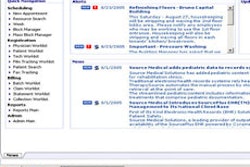To see proof of the effect Linux is having on the technology world today, visit eBay and search for Sun Microsystems equipment. You'll get a good idea of the shift in usage that Linux is effecting as its influence grows in enterprise computing. From garage-based Web sites to industry-leading search technologies, Linux and open source technology are enabling business to develop faster, and grow a reliable and secure infrastructure.
In the past five years, we have seen such giants as the Chicago Mercantile Exchange, Pfizer, and E-Trade upgrade from reduced instruction set computer (RISC)-based systems to faster and cheaper x86-based Linux clusters. To these mass consumers of technology, Linux offers a vehicle to move mission critical systems to cost-efficient hardware. In the case of Frankfurt, Germany-based investment bank Dresdner Kleinwort, this meant a realized savings of $150 million.
Linux is in direct competition with Microsoft Windows for operating system dominance in the enterprise commodity hardware market. Businesses hungry for the cost-savings of PC-based server technology rushed to the Windows platform only to find a much less reliable world compared to their previous UNIX-based systems. The traditional RISC-based administrator shudders at the thought of a world being taken over by a mob of PCs. But long gone are the days when large multimillion-dollar processing refrigerators are needed to run a hospital information system.
Over the years Windows has matured, but it remains problematic in the areas of security and management. In hardened zero-downtime environments previously trusted to mainframes, Windows has not been able to make any significant penetrations. Both born on modern commodity microprocessors, Linux and Windows enjoy a "new kid on the block" swagger that has eased adoption. This is despite traditional operating systems such as Sun's Solaris being available on common Intel architecture.
However, the two do not share much else in common. Linux draws its roots from Unix, and has easily adopted enterprise computing paradigms such as load-sharing clusters and high availability. Both process control and SSL-secured command line access are consistent across Unix and Linux. Not inherently friendly on the desktop, one can easily see why the power of Linux grew up in server technology while the end-user functionality in Windows blossomed on the client side.
Digital radiology computing is currently defined by two major disciplines: the enterprise system powered by Sun Microsystems hardware and software, and the small-scale RIS and PACS systems run almost exclusively on Windows. The low-end Windows-based systems in most cases offer robust radiology solutions to consumers who could not otherwise justify the costs associated with traditional UNIX-based systems. However, they also carry the burden of frequent security updates that can lead to compatibility issues between the RIS/PACS software and the modalities with which it interfaces.
While flourishing in the small- to midscale markets, adoption of Windows server technology in the enterprise RIS/PACS segment has been more tentative. It is in this middle ground between the attractive cost of commodity hardware and the reliability of UNIX that Linux intends to plant its flag. If the rapid adoption by the financial industry is any indicator, its territory could be quite extensive for healthcare, too.
A handful of RIS/PACS vendors are starting to realize this, so they have begun to add Linux to their product offerings. An interesting thing to note is that adoption is occurring at both ends of the spectrum. Typical enterprise vendors such as GE Healthcare and Siemens Medical Solutions, as well as smaller vendors such as Brit Systems and Intelerad Medical Systems, now have Linux-based server offerings. Other companies, such as Medsphere, are harnessing years of open source development from the U.S. Veterans Affairs Vista electronic healthcare record (EHR) system to market its own EHR product.
As was evident throughout the Internet boom of the late 1990s, the European Union (EU) stood strong with its widespread adoption of Linux. Squeezing every last ounce of efficiency from existing computing systems became a necessity for these companies in trying to survive the dot-com crumble.
EU-based businesses are a good example of how companies can flourish by moving to the low-cost components and software packages available through open source. Major adoption of Linux by the German government has set the precedence for how to build efficiently designed systems. One small Heidelberg, Germany-based company, CHILI, has developed a PACS platform featuring end-to-end adoption that harnesses Linux for clinical and diagnostic workstations as well as for server components. In turn, the firm is able to offer its products at prices that smaller clinics and practitioners can afford.
Recently, Siemens Medical Solutions announced that it would be using SuSe Linux and Concurrent software in its Magnetom MRI products. Vendors standardizing with Linux stand to gain efficiencies related to reduced software development costs and shared development efforts. Environments for testing software can be easily constructed using the same low-cost hardware infrastructure from which consumers benefit.
Harnessing a truly modular design approach, these companies and more are showing how building systems with open source software such as MySQL is not only cost-effective it's smart. Leading proprietary and licensed databases are often prohibitively expensive; by building systems from low-cost components it allows manufacturers to pass those savings on to their customers. Herein lays the capitalistic irony with the use of open source software -- manufactures are using these low-cost components as raw materials to sell more complex shrink-wrapped enterprise solutions.
A serendipitous benefit is often derived from the development of seemingly unrelated open source projects. In an open source development project such as Linux, contributors from both the educational and commercial sectors improve on the software collaboratively. It is common for commercial software manufacturers to release improvements or patches to Linux that make their products work better. Support and maintenance for these enhancements often live on in the Linux software, independent of maintenance from the original software manufacturer. It is this utilitarian characteristic that fuels the open source movement.
The possibilities of open source extend well beyond the scope of the client and server operating environments. Vendor support for open database platforms such as MySQL and PostgreSQL is expected to increase along with standardizations on open Web delivery engines such as the Apache Web server and JBoss application server. As healthcare providers continue to become more data-centric, their technology infrastructure will begin to inherit the characteristics and efficiencies of an Internet-era business. For many large healthcare providers, the option to use an open source database platform could account for millions saved each year in proprietary database support costs.
Although there are many reasons to be excited about Linux and open source, there are also reasons to be careful when navigating these new avenues. Healthcare providers looking to explore these operating environments need to confirm the knowledge of their prospective vendors. Vendors should be carefully examined for proficiency with Linux support and their involvement in the development community. Vendors with previous experience with UNIX will transition to Linux support more naturally than vendors that supported only Windows in the past. Vendors that maintain close alliances with Linux distributors and the open source community will often provide a highly integrated environment that keeps system and application updates in harmony.
Additionally, while Linux inherently supports more robust security features than Windows, it should still be scrutinized for conformance to security policies. The information technology (IT) staff needs to understand the operating environment and needs to work with the vendor to ensure the applications are properly configured for secure operation.
With organizations such as the U.S. Federal Aviation Administration entrusting its systems and the safety of the passengers and crews of 8,000 planes to Linux, it is hard to imagine anyone questioning the worthiness of Linux in the healthcare industry. Through reduced cost of ownership, increased performance, and proven reliability, Linux is well-positioned to change the face of healthcare technology to the benefit of everyone.
By G. Francisco Perin
AuntMinnie.com contributing writer
November 3, 2006
Perin is founder and president of Jersey City, NJ-based Zen Engineering Network. He and his partners at Zen Engineering Network are sponsoring a Linux for Healthcare initiative to bring reliable open source solutions to the healthcare industry. The firm can be reached at 212-262-5375 or via its Web site.
Related Reading
Siemens selects Linux for MRI, August 16, 2006
Automated report tracking serves clinical, educational goals, January 18, 2005
AccuSoft brings ImageGear MD to Linux, October 6, 2003
Swiss promote open-source radiology informatics tool, September 5, 2003
RIS/PACS integration defeats data duplication, May 11, 2001
Copyright © 2006 Zen Engineering Network



















